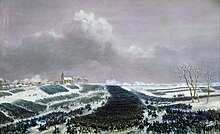Frédéric Henri Walther
Frederic-Louis-Henri Walther | |
|---|---|
Général de division | |
| Battles/wars | War of the First Coalition Count of the Empire. Eastern Pillar, Column 16, Arc de Triomphe . |
Frédéric-Louis-Henri Walther (20 June 1761 – 24 November 1813), was a French
He enlisted in 1781 and, in his 30-year career, he saw action at the major battles in Europe. He fought in
Family
Walther was the son of Georges Henri Walther, a
Initially he enlisted as a simple soldier in the Berchény
Military career
During the
In the
A few days later, he was present for the defeat at the
Napoleonic Wars
During the

At the

During the Saxon campaign of 1813, Walther continued command of the Guard Cavalry, and was present at the Battle of Lützen and Battle of Dresden, as commander of the Guard cavalry.[16] At the Second Battle of Kulm (17 September 1813), he commanded the Imperial Guard Cavalry including the dragoons, Grenadiers à Cheval, and 1st (Polish) and 2nd (Dutch) Lancers.[17] At the Battle of Leipzig, he commanded the 3rd Division of the cavalry of the Imperial Guard: The total cavalry of the Guard included 7,903 men and 18 guns.[18] After refitting and resupply at Erfurt, where Napoleon had stashed a large depot of arms and ammunition, the French army continued to withdraw through western Germany, toward the Rhine.[19]
The
Sources
Notes and citations
- ISBN 2-7010-1261-9, p. 506.
- ^ Louise-Catherine born in 1803 and then Josephine-Napoleone-Frederique-Henriette born on the 14 June 1807. Senior, #7 Frederic-Louis-Henri Walther.
- ^ (in French) Dubois, p. 506.
- ^ Adolphe Le Reboullet, Revue alsacienne. Strasbourg: Berger, 1886-. Volume 9, 1887, p.511.
- ^ Terry J. Senior, "Top 20 French Cavalry Commanders: #7 Frederic-Louis-Henri Walther." Napoleon Series.org, Robert Burnham, editor in chief. Accessed 28 January 2010.
- ^ Tony Broughton, The Garde Imperiale and Its Commanders during the Period 1804 – 1815. Part I: The Cavalry Regiments, Regiment de Grenadiers-a-Cheval de la Garde Imperiale. Napoleon Series. Robert Burnham, editor in chief. Accessed 29 January 2010.
- ^ Andrew Hilliarde Atteridge. The bravest of the brave, Michel Ney: marshal of France, duke of Elchingen. New York: Brentano, 1913, pp. 45–46; p. 48. Lawrence Shadwell. Mountain warfare illustrated by the campaign of 1799 in Switzerland: being a translation of the Swiss narrative, compiled from the works of the Archduke Charles, Jomini, and other... London: Henry S. King, 1875. p. 108–109.
- ^ Senior, #7 Frederic-Louis-Henri Walther.
- ^
ISBN 1-85367-276-9. His division included the 3rd, 6th, 10th, 11th, 13th and 22nd Regiments of Dragoons.
- ^ Senior, #7 Frederic-Louis-Henri Walther.
- ^ Broughton. The Garde Imperiale.
- ^ David Chandler. Dictionary of the Napoleonic wars. Wordsworth editions, 1999. p. 144.
- ^ Smith, "Wagram," Databook, pp. 318–321.
- ^ Rothenberg, p. 192-193.
- ^ Smith, "Borodino," Databook, p. 391.
- ^ Smith, Databook, pp. 416, 443.
- ^ Smith, Databook, p. 455.
- ^ Smith, Databook, p. 461.
- ^ Smith, Databook, p. 473.
- ^ Smith, Databook, p. 474.
- ^ (in French) Révolution et Premier Empire. Histoire et Dictionnaire du consulat et de l'empire A Fierro A palluel guillard J Tulard ed Bouquins, 1995.; Senior, #7 Frederic-Louis-Henri Walther.
Bibliography
- Atteridge, Andrew. The Bravest of the Brave, Michel Ney: Marshal of France, Duke of Elchingen. New York: Brentano, 1913.
- Broughton, Tony. The Garde Imperiale and Its Commanders during the Period 1804 – 1815. Part I: The Cavalry Regiments, Regiment de Grenadiers-a-Cheval de la Garde Imperiale. Napoleon Series. Robert Burnham, editor in chief. Accessed 29 January 2010.
- (in French) Dubois, Jocelyn. "Frederic-Louis-Henri Walther." Les Protestants. André Encrevé (ed.), Paris: Beauchesne, 1993, ISBN 2-7010-1261-9
- LCCN 2006491419.
- Senior, Terry J. "Top 20 French Cavalry Commanders: #7 Frederic-Louis-Henri Walther." Napoleon Series.org, Robert Burnham, editor in chief. Accessed 28 January 2010.
- Shadwell, Lawrence. Mountain Warfare Illustrated by the Campaign of 1799 in Switzerland: Being a Translation of the Swiss Narrative.... London: Henry S. King, 1875.
